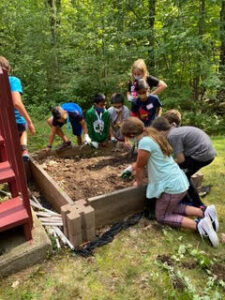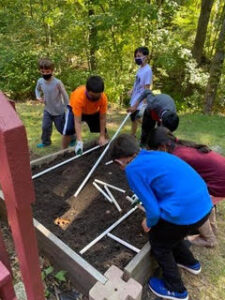Karla Hailer teaches at a private school, Cornerstone Academy, which is located about halfway between Worcester and Boston, Massachusetts. Karla shares why gardening is important for children as the ultimate STEAM activity. (The following has been edited for clarity and length.)
As a kid, I was fascinated by gardens, but gardening was a concept for me, not an action. I discovered Square Foot Gardening when I worked at Borders, but I never really got around to it as a busy mom. Every so often we would grow a few tomatoes and herbs, but I never really “gardened.”

Students add Mel’s Mix™ to their new SFG.
I went into teaching about a decade ago and have been working at a small, private K-6 school on 3 wooded acres. I have the freedom to teach without the demands of high-stakes tests hanging over my head. I love teaching in my looped classroom of fourth-, fifth-, and sixth-grade students. A couple of years ago I had a student who wanted to be a contractor but who hated math with a passion. [The student] struggled with division, didn’t understand a lot of the basic concepts contractors need, and resisted any help. I gave him a contractor’s project. I needed 16 square feet of gardening space to support a Three Sisters garden and only had a budget of $100. The assignment: design the most costefficient raised bed garden he could and calculate costs down to the organic seeds and soil. He designed our 4×4 garden, searched various costs for wood and so forth, and then a miracle happened: he began converting square feet to cubic meters for soil volume! Once he had all his numbers, I told him he needed to summarize and break down the project to convince the principal to allow us to put it in. When the project was finished and we had our first seeds in, he said, “Division is kind of fun. I wish I figured that out earlier.”
Here’s another teachable moment.
Due to the pandemic, our little garden was fallow last spring. When our school returned to in-person teaching in the fall, I wanted a cool-weather crop of fastgrowing plants to start for my plant unit in science. First, we had to weed the rogue grasses that had moved into our box. To keep the kids from “yanking” out parts of the weeds, I offered a homework pass to the group that pulled the longest root without breaking it. We examined those roots to learn how they have a main root and send off small runners to establish themselves, we used iNaturalist to look at the plant to determine what had moved into the box, and so on. My students were fascinated. Once the box was clear and I had mixed in a little compost, we set our grid again and planted Tokyo turnips, watermelon radishes, Dragon carrots, and Rouge d’Hiver and Cimarron lettuces.
 In New England, frost sometimes comes as early as September, sometimes as late as December. This meant adding an engineering component. The kids looked up how to protect our garden by utilizing leftover PVC, plastic sheeting, and whatever else we had on hand from building partitions for in-person learning. We talked about designs: would a greenhouse be better than a row cover? What about a cold frame vs. a hoop tunnel? The students debated thicknesses of plastic sheeting and whether opaque or clear sheeting would be better. They collaborated in groups until they figured it was best to do a simple hoop house with what we had. Of course, the big question was, if we bend a piece of PVC over rebar, will the tension have it “spring” into the woods or stay? They were surprised that it stayed! As one of them said. “I don’t like vegetables, but I’ll try these because I grew them.”
In New England, frost sometimes comes as early as September, sometimes as late as December. This meant adding an engineering component. The kids looked up how to protect our garden by utilizing leftover PVC, plastic sheeting, and whatever else we had on hand from building partitions for in-person learning. We talked about designs: would a greenhouse be better than a row cover? What about a cold frame vs. a hoop tunnel? The students debated thicknesses of plastic sheeting and whether opaque or clear sheeting would be better. They collaborated in groups until they figured it was best to do a simple hoop house with what we had. Of course, the big question was, if we bend a piece of PVC over rebar, will the tension have it “spring” into the woods or stay? They were surprised that it stayed! As one of them said. “I don’t like vegetables, but I’ll try these because I grew them.”
And that is why we teach.
